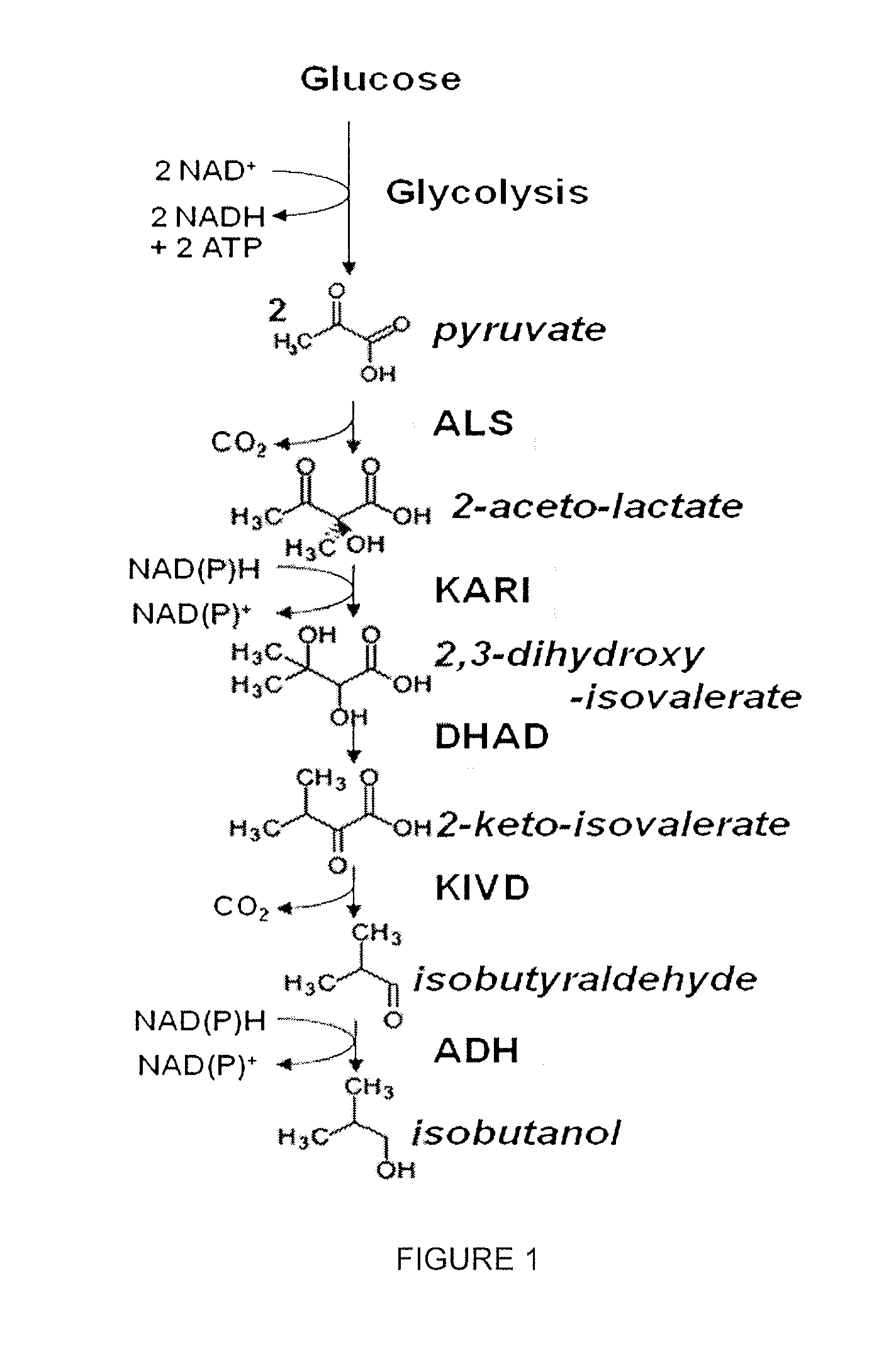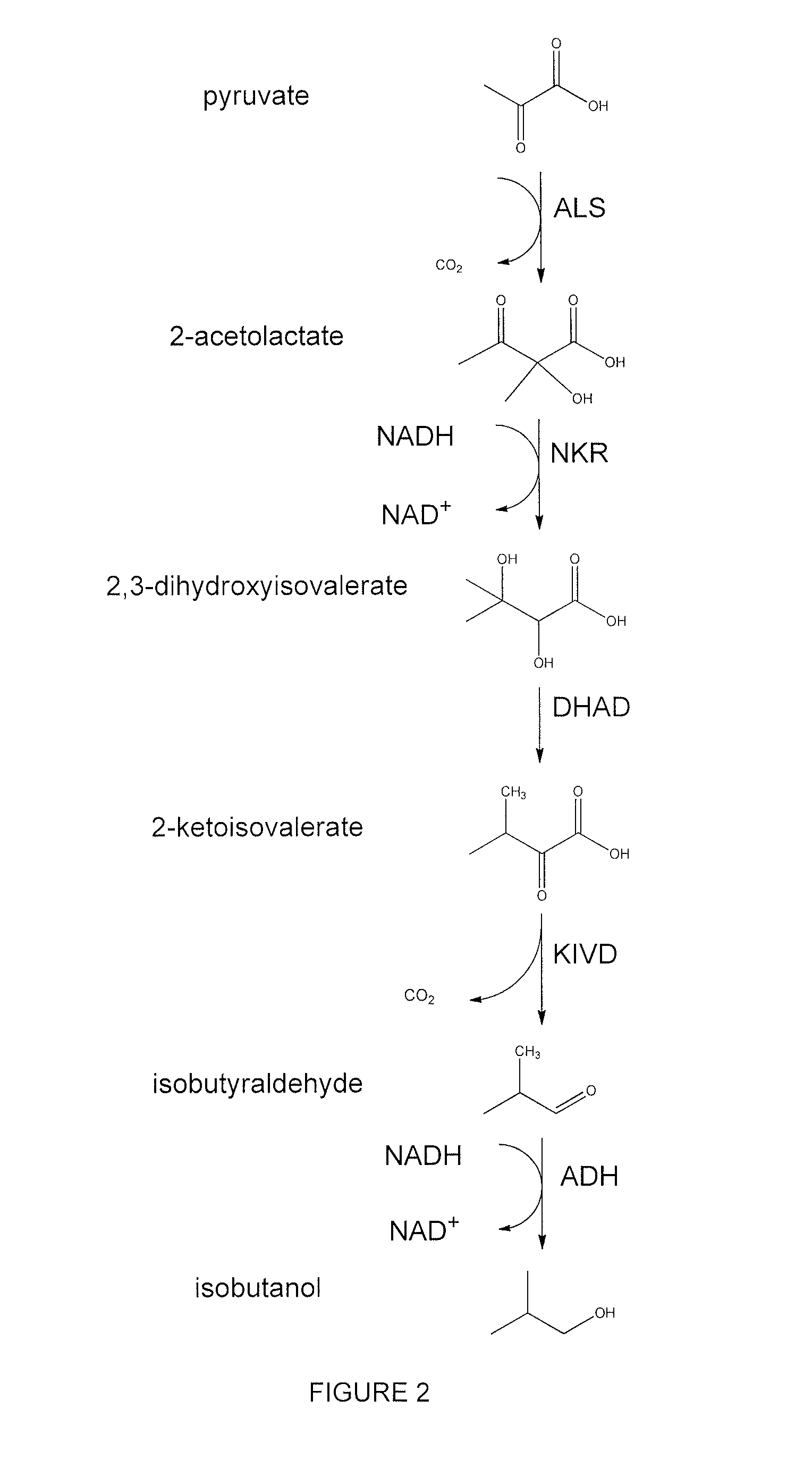Decarboxylase proteins with high keto-isovalerate decarboxylase activity
a decarboxylase and protein technology, applied in the direction of lyase, carbon-carbon lyase, enzymology, etc., can solve the problems of low performance characteristics and shorten the commercial relevance of microorganisms produced to date, and achieve the effect of improving the production of isobutanol and high level activity
- Summary
- Abstract
- Description
- Claims
- Application Information
AI Technical Summary
Benefits of technology
Problems solved by technology
Method used
Image
Examples
example 1
Identification of High-Performance Polypeptides with KIVD Activity
[0282]The purpose of this example is to show how high-performance polypeptides with keto-isovalerate decarboxylase (KIVD) activity were identified. More specifically, this example describes the development of a bioinformatics method to identify proteins which have KIVD (ketoisovalerate decarboxylase) activity but little to no PDC (pyruvate decarboxylase) activity.
Background
[0283]Misannotation of DNA and protein sequences is the assignment of an erroneous functional description to a sequence whose function has not been experimentally determined. The primary source of misannotation is using simple sequence comparison to assign function. With the advent of next generation sequencing technology and the resulting rapid release of new genome sequences, there has been a steady increase in misannotation. Levels of misannotation for over 25% of protein super-families in one or more databases have been observed (Schnoes et al.,...
example 2
Structure-Based Sequence Determinants of Polypeptides with KIVD Specificity
[0298]The purpose of this example is to show how high-performance polypeptides with keto-isovalerate decarboxylase (KIVD) activity were identified using structure-based criteria for predicting the specificity of a polypeptide sequence homolog. Polypeptides exhibiting high keto-isovalerate decarboxylase (KIVD) activity with reduced pyruvate decarboxylase (PDC) activity were identified.
[0299]Polypeptide Identification:
[0300]Protein database BLAST searches revealed several significant hits. Notably, the crystal structures 2vbf (FIG. 5) and 2vbg correspond to the Branched-Chain Keto Acid Decarboxylase from L. lactis (KdcA), an enzyme which exhibits keto-isovalerate decarboxylase activity—crystal structures are available from the Protein Data Bank (“PDB”). KdcA is 88% identical to KivD from L. lactis. 1ovm is an indolepyruvate decarboxylase from E. cloacae (Ec_IPDC, 40% identity to KivD from L. lactis). There are ...
example 3
Evaluation of Decarboxylase Enzymes for KIVD Activity and Substrate Specificity
[0315]The purpose of this example is to show how a high degree of identity to the KIVD substrate specificity motif “SQFVIMF” identified in Example 2 is generally predictive of: (a) high KIVD activity; (b) reduced PDC activity; and (c) a high KIV / pyruvate activity ratio.
[0316]In this example, 16 different decarboxylases representing a cross-section of decarboxylases, with varying degrees of identity to the “SQFVIMF” motif were selected from FIG. 8 and examined through in vitro enzyme assays. Table 3 lists the decarboxylases in a decreasing order of substrate specificity towards KIV as compared to pyruvate based on a statistical scoring mechanism for amino acid residues constituting the “SQFVIMF” motif.
[0317]Experimental Design: All decarboxylases tested in this example were codon-optimized for expression in S. cerevisiae. Plasmids comprising the individual decarboxylase homologs were used to generate trans...
PUM
 Login to View More
Login to View More Abstract
Description
Claims
Application Information
 Login to View More
Login to View More - R&D
- Intellectual Property
- Life Sciences
- Materials
- Tech Scout
- Unparalleled Data Quality
- Higher Quality Content
- 60% Fewer Hallucinations
Browse by: Latest US Patents, China's latest patents, Technical Efficacy Thesaurus, Application Domain, Technology Topic, Popular Technical Reports.
© 2025 PatSnap. All rights reserved.Legal|Privacy policy|Modern Slavery Act Transparency Statement|Sitemap|About US| Contact US: help@patsnap.com



